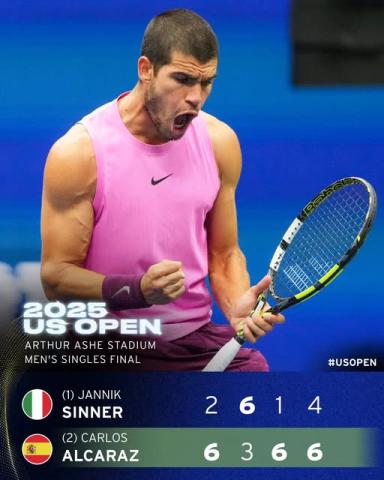
The air on Arthur Ashe Stadium crackled not just with the humidity of a New York night, but with the weight of history. On one side of the net stood Jannik Sinner, the relentless Italian who had dethroned the king, Novak Djokovic, and seemed destined for his first major crown. On the other stood Carlos Alcaraz, the young Spanish phenom, defending not just a title but the very idea of his burgeoning dynasty. What unfolded over four pulsating sets was not merely a tennis match; it was a high-octane chess match played at bullet speed, a testament to the future of the sport, culminating in a 6-4, 7-6(7), 6-3 victory for Alcaraz, securing his second US Open title.
The Stage is Set: A Clash of Styles and Wills
From the first ball, the narrative was clear. This was a clash of two of the most explosive and complete games in modern tennis. Sinner, the flat-line aggressor, sought to bludgeon the ball from the baseline, using his rocket-like forehand and precise backhand to dictate terms and shorten points. Alcaraz, the virtuoso, entered with a more complex blueprint: to disrupt Sinner’s rhythm, blend immense power with breathtaking touch, and turn the court into his personal playground.
The first set was a masterclass in tactical discipline from Alcaraz. Recognizing Sinner’s comfort in backhand-to-backhand exchanges, Alcaraz made a crucial adjustment. He repeatedly used his heavy, kicking serve wide to the Sinner forehand in the deuce court, opening up the court and following it with ferocious forehands into the vacant space. He broke early and, despite facing pressure on his own serve, held firm with a combination of blistering 130+ mph serves and clutch drop shots that left Sinner stranded. He sealed the set 6-4, sending a clear message: he was here to fight.
The Crucible: A Second Set for the Ages
If the first set was a statement, the second was an epic poem. It was a set that stretched the limits of physical and mental endurance, lasting an grueling 84 minutes. Sinner, stung by the first-set loss, elevated his game to terrifying levels. He began reading the Alcaraz serve, returning with deeper, more aggressive intent, and broke to take a 4-2 lead. The momentum had swung violently.
But champions find a way when the path disappears. With Sinner serving for the set at 5-4, Alcaraz unleashed his champion’s heart. He fought off set points not with luck, but with audacity—a ripping cross-court winner, a fearless approach to the net. He broke back, sending the crowd into a frenzy and the match into a tiebreak.
The tiebreak was a microcosm of the entire battle. Sinner again seized control, carving out a 6-5 lead and another set point. The entire match hung on a single point. Alcaraz, facing the abyss, responded with sheer brilliance. He served and volleyed, a bold, old-school tactic that caught Sinner off guard, to save it. Two points later, it was Alcaraz who earned a set point of his own. The point that followed was pure magic: a breathtaking, 26-shot rally that saw both players cover every inch of the blue hard court, defending, attacking, and counter-attacking. It was Alcaraz who finally ended it, forcing a Sinner error to claim the set 9-7 in the tiebreak. The roar from the crowd was deafening. Alcaraz had not just won a set; he had stolen Sinner’s soul.
The Adjustments: How the Champion Seized Control
The key to Alcaraz’s victory lay in his intelligent mid-match adjustments:
-
Neutralizing the Sinner Return: After Sinner began cracking his returns, Alcaraz started mixing his serve placement and pace more effectively, throwing in body serves and sharper slices to break the Italian’s rhythm.
-
The Forehand-to-Forehand Battle: Alcaraz consciously shifted the pattern of play. Instead of engaging in backhand exchanges, he used his inside-out forehand to drag Sinner wide into the forehand corner, exposing the Italian’s movement and creating angles to finish points.
-
The Drop Shot as a Weapon: In the grueling rallies, Alcaraz used his devastating drop shot not just to win points outright, but to exhaust Sinner physically and mentally. Each perfectly weighted drop shot forced Sinner to sprint forward, sapping his energy for the next baseline explosion.
-
Embracing the Volley: Alcaraz approached the net 45 times, winning a staggering 80% of those points. This aggressive tactic cut points short and put continuous pressure on Sinner to produce passing-shot perfection.
The Coronation: Closing with Ruthless Efficiency
The psychological blow of losing the second set was too much for Sinner to overcome. The fire and precision that defined his game began to flicker. Alcaraz, smelling blood, became ruthless. He broke early in the third set, his confidence now soaring. The dizzying array of shots—the whipped forehand winners, the deft volleys, the unreturnable serves—continued to flow.
Serving for the championship at 5-3, there was no drama, no final twist. Carlos Alcaraz, with the poise of a veteran and the joy of a prodigy, closed out the match with a hold to love, culminating in a service winner that Sinner could only return long.
As he fell to the court, arms outstretched and face beaming with a mixture of ecstasy and relief, the truth was undeniable. In a match that demanded everything, Carlos Alcaraz had given everything and more. He didn’t just beat Jannik Sinner; he overcame a monumental challenge with a blend of strategic genius, physical prowess, and an indomitable will. He is a two-time US Open champion, and at just 21 years old, the throne of men’s tennis feels firmly, and thrillingly, his to occupy.
